新版PEP小学六年级上册英语上册导学案 全册
- 格式:doc
- 大小:165.51 KB
- 文档页数:12
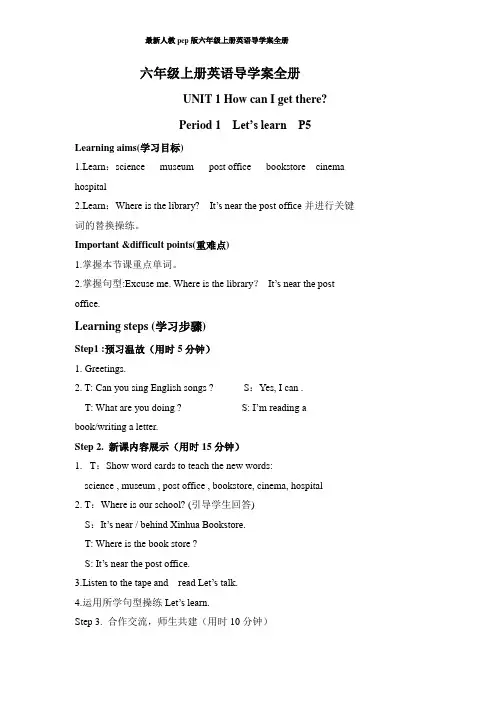
六年级上册英语导学案全册UNIT 1 How can I get there?Period 1 Let’s learn P5 Learning aims(学习目标)1.Learn:science museum post office bookstore cinema hospital2.Learn:Where is the library? It’s near the post office并进行关键词的替换操练。
Important &difficult points(重难点)1.掌握本节课重点单词。
2.掌握句型:Excuse me. Where is the library?It’s near the post office.Learning steps (学习步骤)Step1 :预习温故(用时5分钟)1. Greetings.2. T: Can you sing English songs ? S:Yes, I can .T: What are you doing ? S: I’m reading abook/writing a letter.Step 2. 新课内容展示(用时15分钟)1.T:Show word cards to teach the new words:science , museum , post office , bookstore, cinema, hospital2. T:Where is our school? (引导学生回答)S:It’s near / behind Xinhua Bookstore.T: Where is the book store ?S: It’s near the post office.3.Listen to the tape and read Let’s talk.4.运用所学句型操练Let’s learn.Step 3. 合作交流,师生共建(用时10分钟)1.运用图片操练重要单词和词组。

六年级上册英语导学案 Unit 1 Part A Let's learn 人教PEP一、教学目标:1. 知识目标:(1)能够听懂、会说、会读本节课的主要词汇:drawing, writing, painting, singing, dancing。
(2)能够听懂、会说、会读本节课的主要句型:What can you do? I can sing. 和 Can he/she do sth? Yes, he/she can. No,he/she can't.(3)能够理解并在适当的情境中运用本节课的主要句型和词汇。
2. 能力目标:(1)能够通过图片和情景,正确使用所学的词汇和句型进行交流。
(2)能够运用所学的词汇和句型,进行简单的角色扮演和表演。
3. 情感目标:(1)培养学生的合作意识和团队精神。
(2)培养学生的自信心,让他们敢于开口,乐于交流。
二、教学内容:1. 词汇:drawing, writing, painting, singing, dancing。
2. 句型:What can you do? I can sing. 和 Can he/she do sth? Yes, he/she can. No, he/she can't.三、教学重点与难点:1. 重点:词汇drawing, writing, painting, singing, dancing 的学习和运用;句型What can you do? I can sing. 和 Can he/she do sth? Yes, he/she can. No, he/she can't. 的学习和运用。
2. 难点:词汇的准确发音和运用;句型的适当运用和变化。
四、教具与学具准备:1. 教具:教材、课件、黑板、粉笔。
2. 学具:课本、练习本、文具。
五、教学过程:1. 导入:通过歌曲或游戏,引导学生进入学习状态,激发他们的学习兴趣。
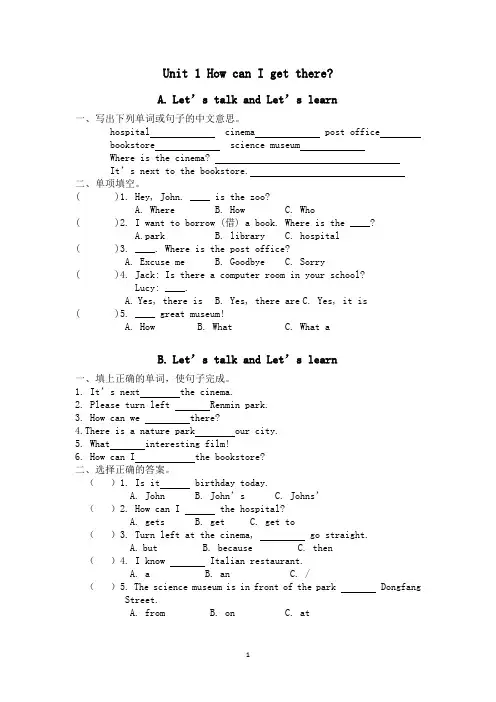
Unit 1 How can I get there?A.Let’s talk and Let’s learn一、写出下列单词或句子的中文意思。
hospital cinema post office bookstore science museumWhere is the cinema?It’s next to the bookstore.二、单项填空。
( )1. Hey, John. ____ is the zoo?A. WhereB. HowC. Who( )2. I want to borrow (借) a book. Where is the ____?A.parkB. libraryC. hospital( )3. ____. Where is the post office?A. Excuse meB. GoodbyeC. Sorry( )4. Jack: Is there a computer room in your school?Lucy: ____.A.Yes, there isB. Yes, there areC. Yes, it is( )5. ____ great museum!A. HowB. WhatC. What aB.Let’s talk and Let’s learn一、填上正确的单词,使句子完成。
1. It’s next the cinema.2. Please turn left Renmin park.3. How can we there?4.There is a nature park our city.5. What interesting film!6. How can I the bookstore?二、选择正确的答案。
()1. Is it birthday today.A. JohnB. John’sC. Johns’()2. How can I the hospital?A. getsB. getC. get to()3. Turn left at the cinema, go straight.A.butB. becauseC. then()4. I know Italian restaurant.A. aB. anC. /()5. The science museum is in front of the park Dongfang Street.A. fromB. onC. atB.Read and write一、根据句意,选择正确的单词,补全句子。
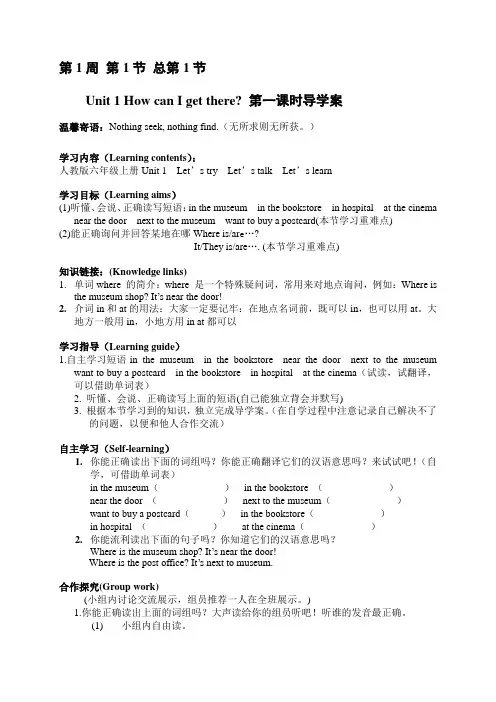
第1周第1节总第1节Unit 1 How can I get there? 第一课时导学案温馨寄语:Nothing seek, nothing find.(无所求则无所获。
)学习内容(Learning contents):人教版六年级上册Unit 1 Let’s try Let’s talk Let’s learn学习目标(Learning aims)(1)听懂、会说、正确读写短语:in the museum in the bookstore in hospital at the cinemanear the door next to the museum want to buy a postcard(本节学习重难点)(2)能正确询问并回答某地在哪Where is/ar e…?It/They is/are…. (本节学习重难点)知识链接:(Knowledge links)1.单词where 的简介:where 是一个特殊疑问词,常用来对地点询问,例如:Where isthe museum shop? It’s near the door!2.介词in和at的用法:大家一定要记牢:在地点名词前,既可以in,也可以用at。
大地方一般用in,小地方用in at都可以学习指导(Learning guide)1.自主学习短语in the museum in the bookstore near the door next to the museumwant to buy a postcard in the bookstore in hospital at the cinema(试读,试翻译,可以借助单词表)2. 听懂、会说、正确读写上面的短语(自己能独立背会并默写)3. 根据本节学习到的知识,独立完成导学案。
(在自学过程中注意记录自己解决不了的问题,以便和他人合作交流)自主学习(Self-learning)1.你能正确读出下面的词组吗?你能正确翻译它们的汉语意思吗?来试试吧!(自学,可借助单词表)in the museum()in the bookstore ()near the door ()next to the museum()want to buy a postcard()in the bookstore()in hospital ()at the cinema()2.你能流利读出下面的句子吗?你知道它们的汉语意思吗?Where is the museum shop? It’s near the door!Where is the post office? It’s next to museum.合作探究(Group work)(小组内讨论交流展示,组员推荐一人在全班展示。

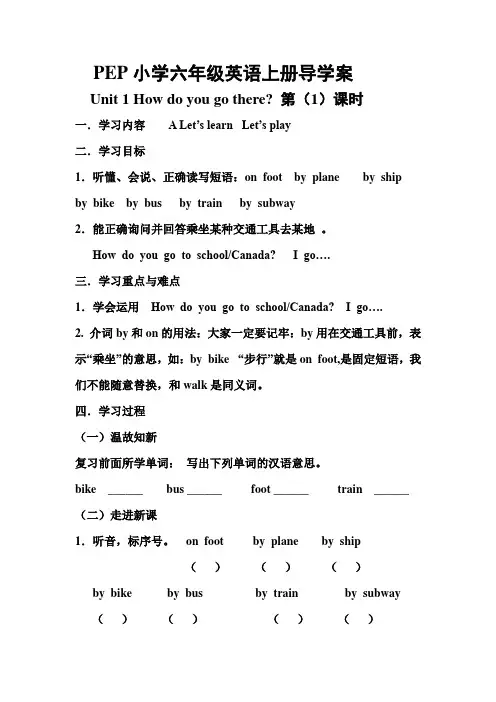
PEP小学六年级英语上册导学案Unit 1 How do you go there? 第(1)课时一.学习内容 A Let’s learn Let’s play二.学习目标1.听懂、会说、正确读写短语:on foot by plane by shipby bike by bus by train by subway2.能正确询问并回答乘坐某种交通工具去某地。
How do you go to school/Canada? I go….三.学习重点与难点1.学会运用How do you go to school/Canada? I go….2. 介词by和on的用法:大家一定要记牢:by用在交通工具前,表示“乘坐”的意思,如:by bike “步行”就是on foot,是固定短语,我们不能随意替换,和walk是同义词。
四.学习过程(一)温故知新复习前面所学单词:写出下列单词的汉语意思。
bike ______ bus ______ foot ______ train ______ (二)走进新课1.听音,标序号。
on foot by plane by ship()()()by bike by bus by train by subway ()()()()2.选择正确答案。
(1)I go to school ______ foot.A. onB. byC. in(2)______ do you go to the USA?A. WhatB. HowC. When(3)I go to Canada ______ plane.A. onB. byC. in(三)课堂巩固练习1.翻译下列词汇。
(1)on foot ______ (2)by plane ______(3)by ship ______ (4)by bike______ (5)by bus______ (6)by train______(7)by subway______(四).课后作业1.按格式正确抄写A Let’s learn 的短语。
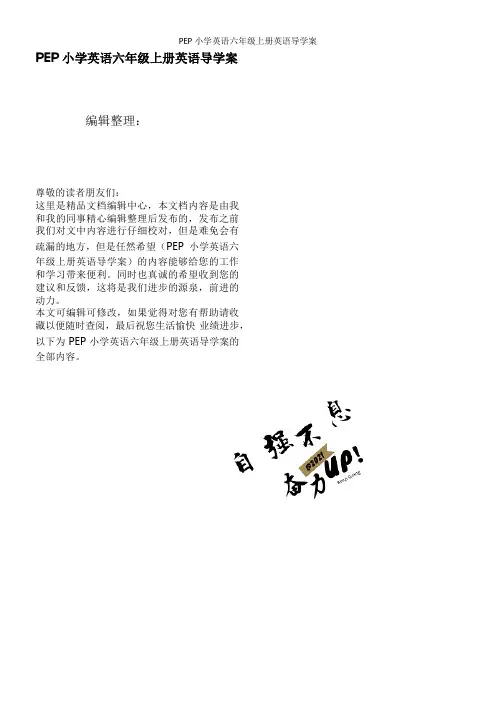
PEP小学英语六年级上册英语导学案PEP小学英语六年级上册英语导学案编辑整理:尊敬的读者朋友们:这里是精品文档编辑中心,本文档内容是由我和我的同事精心编辑整理后发布的,发布之前我们对文中内容进行仔细校对,但是难免会有疏漏的地方,但是任然希望(PEP小学英语六年级上册英语导学案)的内容能够给您的工作和学习带来便利。
同时也真诚的希望收到您的建议和反馈,这将是我们进步的源泉,前进的动力。
本文可编辑可修改,如果觉得对您有帮助请收藏以便随时查阅,最后祝您生活愉快业绩进步,以下为PEP小学英语六年级上册英语导学案的全部内容。
Unit 1 How do you go there? 第一课时导学案温馨寄语:Nothing seek, nothing find。
(无所求则无所获.)学习内容(Learning contents):人教版六年级上册Unit 1 PartA Let's learn Let's play学习目标(Learning aims)(1)听懂、会说、正确读写短语:on foot by bike by bus by train by plane by ship by subway(本节学习重难点)(2)能正确询问并回答乘坐某种交通工具去某地How do you go to school/Canada?I go….(本节学习重难点)知识链接:(Knowledge links)1.单词how 的简介:h ow 是一个特殊疑问词,常用来对身体状况进行询问,例如:How are you? I'm fine.Thank you!在本节的学习中,how 还有另外一种用法,主要对交通方式提问.2.介词by和on的用法:大家一定要记牢:by用在交通工具前,表示“乘坐”的意思,如:by bike “步行"就是on foot,是固定短语,我们不能随意替换,和walk是同义词。
学习指导(Learning guide)1。
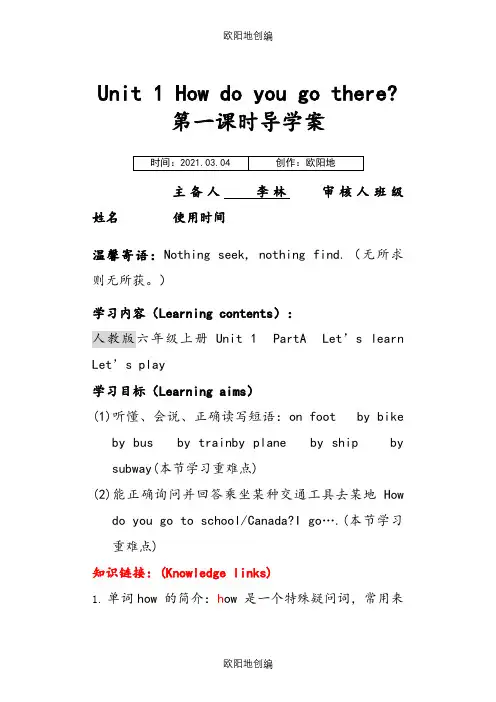
Unit 1 How do you go there?第一课时导学案主备人李林审核人班级姓名使用时间温馨寄语:Nothing seek, nothing find.(无所求则无所获。
)学习内容(Learning contents):人教版六年级上册Unit 1 PartA Let’s learn Let’s play学习目标(Learning aims)(1)听懂、会说、正确读写短语:on foot by bikeby bus by trainby plane by ship bysubway(本节学习重难点)(2)能正确询问并回答乘坐某种交通工具去某地Howdo you go to school/Canada?I go….(本节学习重难点)知识链接:(Knowledge links)1.单词how 的简介:h ow 是一个特殊疑问词,常用来对身体状况进行询问,例如:How are you? I’m fine.Thank you!在本节的学习中,how 还有另外一种用法,主要对交通方式提问。
2.介词by和on的用法:大家一定要记牢:by用在交通工具前,表示“乘坐”的意思,如:by bike “步行”就是on foot,是固定短语,我们不能随意替换,和walk是同义词。
学习指导(Learning guide)1.自主学习短语on foot by bike by busby trainby plane by ship by subway(试读,试翻译,可以借助单词表)2.听懂、会说、正确读写上面的短语(自己能独立背会并默写)3.根据本节学习到的知识,独立完成导学案。
(在自学过程中注意记录自己解决不了的问题,以便和他人合作交流)自主学习(Self-learning)1.你能正确读出下面的词组吗?你能正确翻译它们的汉语意思吗?来试试吧!(自学,可借助单词表)on foot( ) by bike ( )by bus( )by train ( )by plane( )by ship( )by subway( )2.你能流利读出下面的句子吗?你知道它们的汉语意思吗?How do you go to school? I go to school by bike.How do you go toCanada?I go by plane.合作探究(Group work)(小组内讨论交流展示,组员推荐一人在全班展示。
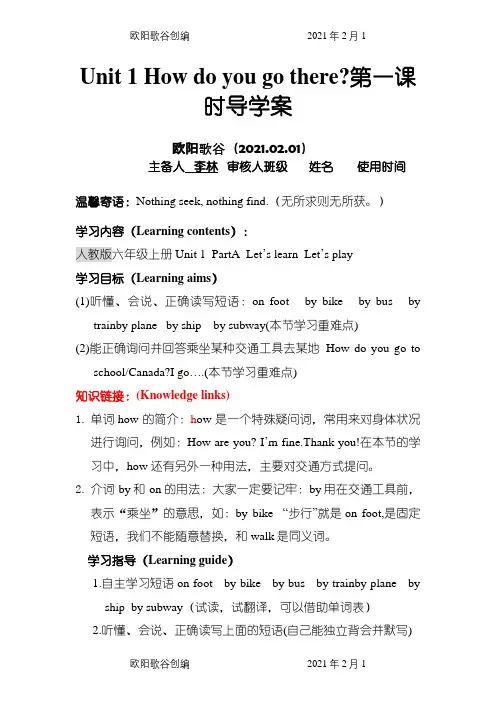
Unit 1 How do you go there?第一课时导学案欧阳歌谷(2021.02.01)主备人李林审核人班级姓名使用时间温馨寄语:Nothing seek, nothing find.(无所求则无所获。
)学习内容(Learning contents):人教版六年级上册Unit 1 PartA Let’s learn Let’s play学习目标(Learning aims)(1)听懂、会说、正确读写短语:on foot by bike by bus bytrainby plane by ship by subway(本节学习重难点)(2)能正确询问并回答乘坐某种交通工具去某地How do you go toschool/Canada?I go….(本节学习重难点)知识链接:(Knowledge links)1.单词how 的简介:h ow 是一个特殊疑问词,常用来对身体状况进行询问,例如:How are you? I’m fine.Thank you!在本节的学习中,how 还有另外一种用法,主要对交通方式提问。
2.介词by和on的用法:大家一定要记牢:by用在交通工具前,表示“乘坐”的意思,如:by bike “步行”就是on foot,是固定短语,我们不能随意替换,和walk是同义词。
学习指导(Learning guide)1.自主学习短语on foot by bike by bus by trainby plane byship by subway(试读,试翻译,可以借助单词表)2.听懂、会说、正确读写上面的短语(自己能独立背会并默写)3.根据本节学习到的知识,独立完成导学案。
(在自学过程中注意记录自己解决不了的问题,以便和他人合作交流)自主学习(Self-learning)1.你能正确读出下面的词组吗?你能正确翻译它们的汉语意思吗?来试试吧!(自学,可借助单词表)on foot( ) by bike ( )by bus( )by train ( )by plane( )by ship( )by subway( )2.你能流利读出下面的句子吗?你知道它们的汉语意思吗?How do you go to school? I go to school by bike.How do you go toCanada?I go by plane.合作探究(Group work)(小组内讨论交流展示,组员推荐一人在全班展示。
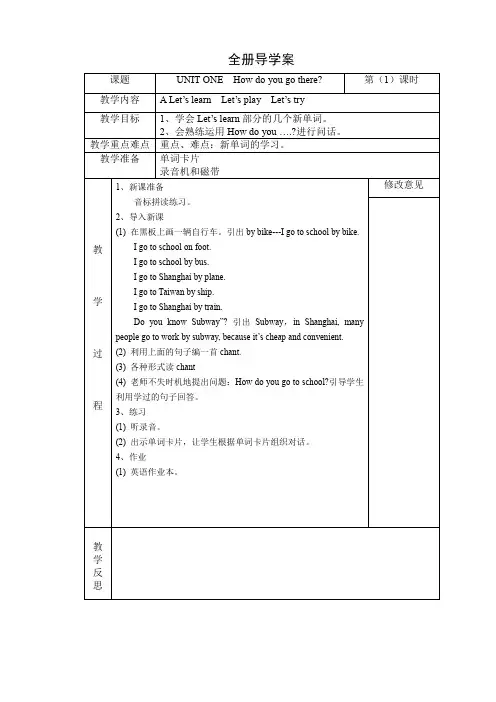
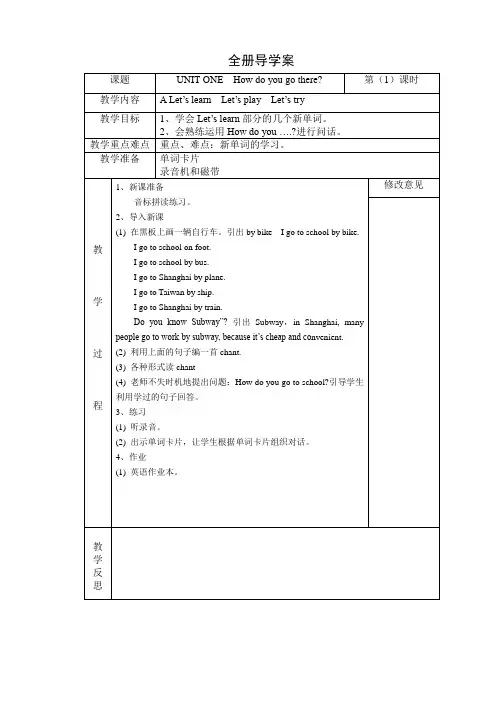
Unit 1 How do you go there?第一课时导学案主备人李林审核人班级姓名使用时间温馨寄语:Nothing seek, nothing find.(无所求则无所获。
)学习内容(Learning contents):人教版六年级上册Unit 1 PartA Let’s learn Let’s play学习目标(Learning aims)(1)听懂、会说、正确读写短语:on foot by bike by bus bytrainby plane by ship by subway(本节学习重难点)(2)能正确询问并回答乘坐某种交通工具去某地How do you go toschool/Canada?I go….(本节学习重难点)知识链接:(Knowledge links)1.单词how 的简介:h ow 是一个特殊疑问词,常用来对身体状况进行询问,例如:How are you? I’m fine.Thank you!在本节的学习中,how 还有另外一种用法,主要对交通方式提问。
2.介词by和on的用法:大家一定要记牢:by用在交通工具前,表示“乘坐”的意思,如:by bike “步行”就是on foot,是固定短语,我们不能随意替换,和walk是同义词。
学习指导(Learning guide)1.自主学习短语on foot by bike by bus by trainby plane byship by subway(试读,试翻译,可以借助单词表)2.听懂、会说、正确读写上面的短语(自己能独立背会并默写)3.根据本节学习到的知识,独立完成导学案。
(在自学过程中注意记录自己解决不了的问题,以便和他人合作交流)自主学习(Self-learning)1.你能正确读出下面的词组吗?你能正确翻译它们的汉语意思吗?来试试吧!(自学,可借助单词表)on foot( ) by bike ( )by bus( )by train ( )by plane( )by ship( )by subway( )2.你能流利读出下面的句子吗?你知道它们的汉语意思吗?How do you go to school? I go to school by bike.How do you go toCanada?I go by plane.合作探究(Group work)(小组内讨论交流展示,组员推荐一人在全班展示。
第1周第1节总第1节Unit 1 How can I get there? 第一课时导学案温馨寄语:Nothing seek, nothing find.(无所求则无所获。
)学习内容(Learning contents):人教版六年级上册Unit 1 Let’s try Let’s talk Let’s learn学习目标(Learning aims)(1)听懂、会说、正确读写短语:in the museum in the bookstore in hospital at the cinemanear the door next to the museum want to buy a postcard(本节学习重难点)(2)能正确询问并回答某地在哪Where is/ar e…?It/They is/are…. (本节学习重难点)知识链接:(Knowledge links)1.单词where 的简介:where 是一个特殊疑问词,常用来对地点询问,例如:Where isthe museum shop? It’s near the door!2.介词in和at的用法:大家一定要记牢:在地点名词前,既可以in,也可以用at。
大地方一般用in,小地方用in at都可以学习指导(Learning guide)1.自主学习短语in the museum in the bookstore near the door next to the museumwant to buy a postcard in the bookstore in hospital at the cinema(试读,试翻译,可以借助单词表)2. 听懂、会说、正确读写上面的短语(自己能独立背会并默写)3. 根据本节学习到的知识,独立完成导学案。
(在自学过程中注意记录自己解决不了的问题,以便和他人合作交流)自主学习(Self-learning)1.你能正确读出下面的词组吗?你能正确翻译它们的汉语意思吗?来试试吧!(自学,可借助单词表)in the museum()in the bookstore ()near the door ()next to the museum()want to buy a postcard()in the bookstore()in hospital ()at the cinema()2.你能流利读出下面的句子吗?你知道它们的汉语意思吗?Where is the museum shop? It’s near the door!Where is the post office? It’s next to museum.合作探究(Group work)(小组内讨论交流展示,组员推荐一人在全班展示。
)1.你能正确读出上面的词组吗?大声读给你的组员听吧!听谁的发音最正确。
(1)小组内自由读。
(2)小组推荐优秀组员展示读,并领读,全班同学跟读。
2.你能用英语写出下面的句子吗?(1)博物馆商店在哪里?他在们附近。
_____________________________________________________(2)邮局在哪里?他挨着博物馆。
____________________________________________________小组展示(Group show)对合作探究中的两个问题进行展示。
课堂小结(Summary)这节课我学会了____________________________________________________________________________________________________。
巩固延伸(Consolidation and extension)Talk about the museum shop/post office?Talk about the places in your city/town/village?Is there a…?It’s near/next to/behind…课堂检测(Test)1.你能写出正确的短语吗?在邮局_______________ 想买一张贺卡______________打扰了_______________ 挨着博物馆______________我不知道_____________ 一个说话的机器人______________2.连词成句:(1) post where office the is________________________________________(2)bookstore it’s next the to._________________________________________后记第1周第2节总第2节Unit 1 How can I get there?第二课时导学案温馨寄语:No pain,no gain.(不劳无获。
)学习内容(Learning contents):人教版六年级上册Unit 1 Make a map and talk Let’s try Let’s talk学习目标(Learning aims)1.能听懂、会说、流利读、正确书写四会句子:“How can we get there? Turn left at the bookstore. Then turn right at the hospital.”(本节课学习重点)2.能够听懂Let's try的录音内容并选出正确选项3.能够表述问路及指点路,如:How can we get there? Turn left at the bookstore. Then turn right at the hospital.(本节课学习难点)知识链接:(Knowledge links)1.There be句型:表示某地有某物。
2.单词how 的简介:how 是一个特殊疑问词,常用来对身体状况进行询问,例如:Howare you? I’m fine.Thank you!在本节的学习中,how 还有另外一种用法,主要对方式提问学习指导(Learning guide)1.自主学习对话(试读试翻译,可以借助单词表,不会的注意作标记)2.流利背诵对话。
(自己能独立背并默写重点句型)3.根据本节学习到的知识,独立完成导学案。
旧知复习(Revision)写词。
科学博物馆________________ 邮局__________________书店_________________ 电影院____________医院_________________ 图书馆_____________自主学习(Self-learning)1.你能完成听音练习吗?Listen and tick or cross.( ) They want to go to the bookstore.( ) The cinema is next to the bookstore.2.你能正确读出下面的句子吗?你能正确翻译它们的汉语意思吗?来试试吧!(自学,可同桌交流)How can we get therel?Turn left at the bookstore.Then turn right at the hosipal.合作探究(Group work)(小组内讨论交流展示,组员推荐一人在全班展示。
)1.你能流利朗读对话吗?大声读给你的组员听吧!听谁的发音最正确。
(1)小组内自由读。
(2)各小组长领读,全班跟读。
(3)小组推荐优秀组员分角色表演。
2.你能用英语写出下面的句子吗?(1)我们怎么能到那?在书店向左转,然后在医院向右转。
_____________________________________________________(2)它在东方大街,挨着公园。
____________________________________________________小组展示(Group show)对合作探究中的两个问题进行展示。
课堂小结(Summary)这节课我学会___________________________________________巩固延伸(Consolidation and extension)1.看图仿写对话(课本第六页)。
2.组内展示所写对话。
3.小组交流,完成Group work.I like…How can I get to the…Turn left/right at…课堂检测(Test)一.连词成句。
1.I how get can to Zhongshan Park(?)________________________________________2.left turn the at bookstore(?)_______________________二.改错,并纠正。
1.Howcan you go school? _______→_______2.Turn the left at the bookstore. _______→_______3. What a interesting film. _______→_______4.Turn righton the hospital _______→_______5.What can I go there? _______→_______后记第1周第3节总第3节Unit 1 How can I get there? 第三课时导学案温馨寄语:Practice makes perfect.(实践出真知)学习内容(Learning contents):人教版六年级上册Unit 1Let's learn Be a tour guide学习目标(Learning aims)(1)能够流利朗读Let's learn部分的内容,并能记住短语及句子。
(本节学习重点) (2)能看图指点方向(本节学习难点)知识链接:(Knowledge links)1.问路How can I get t o the…2.指路Turn left/right a t…。
3.情态动词can后用动词原形。
4.叙述某件事情的发生顺序时,要学会用first, next, then这三个词。
学习指导(Learning guide)1.自主学习短文(试读,试翻译,画出词组,可以借助单词表,不理解的作标记)。
2.组内解决标记的疑难单词。
3.流利朗读对话。
4.自主学习识图并且会指路。
(不会的向老师请教)5.根据本节学习到的知识,独立完成导学案。
旧知复习(Revision)复习背诵上节课学过的对话(小组集体背诵)。